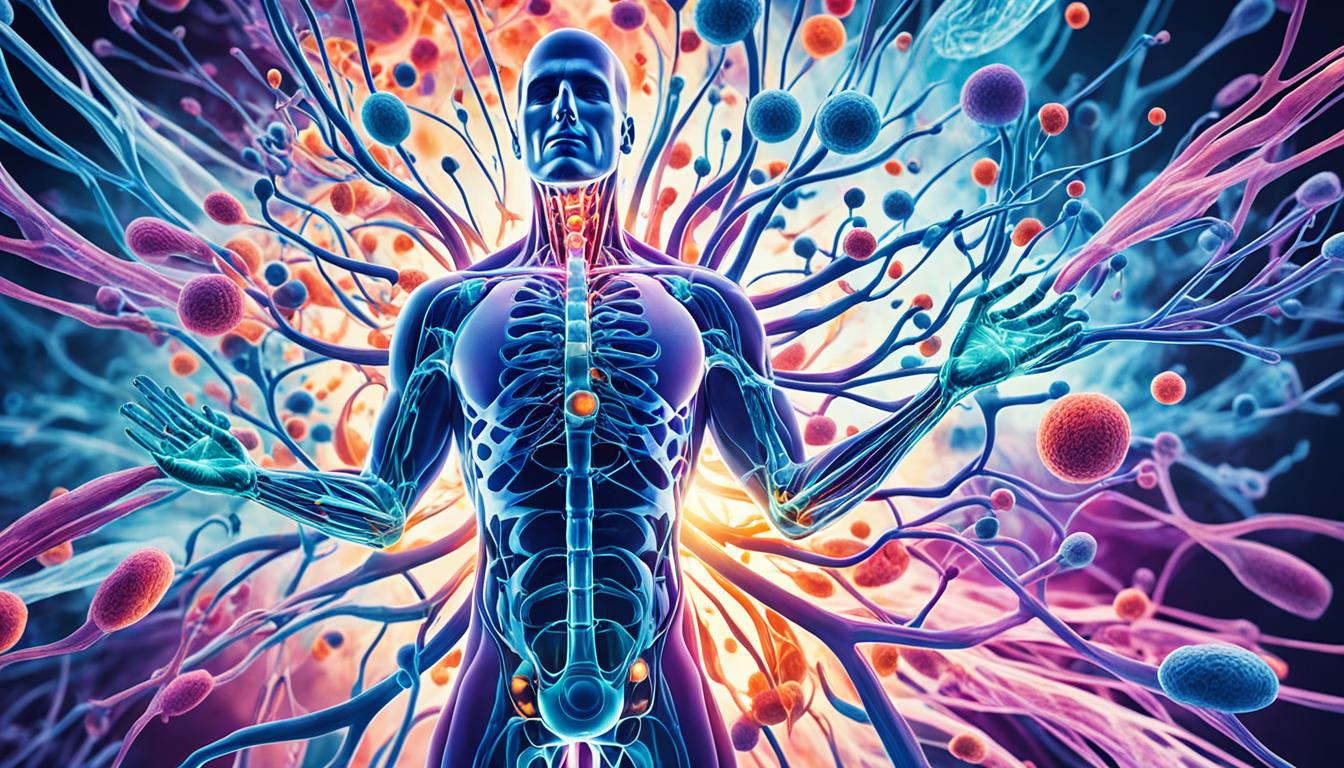Hypereosinophilic syndrome (HES) is a rare blood disorder marked by a high count of eosinophils, a kind of white blood cell. These cells are crucial for the immune system. The syndrome can harm several organs, like the skin, lungs, and heart. People with HES might feel tired, cough, and get rashes. This condition often affects men between 20 and 50 years old more.
Various factors can lead to HES, like genetics, cancers, and certain diseases. It’s essential to understand these risk factors for early diagnosis and management.
To diagnose HES, doctors look for excessive eosinophils that cause organ damage. They must rule out other reasons for high eosinophils, including allergies and parasites. Treatment of HES varies based on its severity and underlying causes. Stem cell therapy is a promising treatment. Early diagnosis greatly improves the chances of managing HES successfully.
Key Takeaways:
- Hypereosinophilic syndrome (HES) is a rare blood disorder characterized by high numbers of eosinophils.
- HES can cause damage to various organs and may manifest symptoms such as fatigue, cough, breathlessness, muscle pain, rash, and fever.
- The causes of HES can vary, including genetic factors, certain types of cancers, infections, and other health problems.
- Early diagnosis is crucial for proper management and prognosis of HES.
- Stem cell therapy is one of the treatment options for HES.
Symptoms of Hypereosinophilic Syndrome
Hypereosinophilic syndrome (HES) brings various symptoms. It’s important to know these signs for an early diagnosis. This can help manage the disease better. Common symptoms include:
- Fatigue: People with HES often feel very tired and have low energy. This fatigue can stop them from doing daily tasks and lower their life quality.
- Cough: A long-lasting cough is common in HES patients. It might not produce mucus or could come with mucus.
- Breathlessness: Finding it hard to breathe, especially when active, is a key symptom. It might come with wheezing or fast breaths.
- Muscle pain: HES can make your muscles ache (myalgia). The pain might be in one spot or all over and could weaken your muscles.
- Rash: Skin rashes or hives can show up. They could be itchy, red, or raised, and appear anywhere on the body.
- Fever: Sometimes, HES causes periods of fever, which could be mild or high.
If you are facing some of these issues, it might be HES. But, always check with a doctor for a clear answer. Getting medical help quickly is important. It allows for finding the real cause and the right treatments.
Impact on Organ Function
HES symptoms tie back to too many eosinophils in the body. These white blood cells can build up in organs. This leads to swelling and damage over time. This damage can reduce how well organs work.
Too many eosinophils in the lungs can cause cough and trouble breathing. They can also affect the skin, leading to rashes. When they get into the muscles, it causes pain. Eosinophils can trigger fevers as a widespread reaction. Fatigue can be from the effect on different organs and from the body fighting this issue.
Recognizing and treating HES early is key to stopping organ harm. Act quickly to get a better outlook.
Causes and Risk Factors of Hypereosinophilic Syndrome
Hypereosinophilic syndrome (HES) is a rare blood disorder with high eosinophil counts. It has many causes and risk factors. Knowing these can help find the condition early and treat it correctly.
Genetic Factors
Some people with HES have a family history of it. Genes can affect how the disease grows. Those with relatives who had HES should have regular checks to catch it early.
Cancers and Infections
Cancer can sometimes cause HES by disrupting the immune system. It might lead to too many eosinophils. Infections like parasites, bacteria, or viruses can also play a part. They cause inflammation, which increases eosinophil levels.
Other Underlying Health Problems
HES can be tied to autoimmune disorders, allergies, and inflammation. These issues interfere with the immune system. Then, eosinophil levels go up.
Demographic Factors
HES is seen more in men from 20 to 50 years old. We aren’t sure why this is yet. It might involve hormonal or environmental effects on HES development.
Knowing about the causes and risks of HES is important for healthcare workers. They can use this knowledge to spot and treat the condition early. This can lead to better outcomes for HES patients.
Diagnosis and Treatment Options for Hypereosinophilic Syndrome
Diagnosing hypereosinophilic syndrome (HES) means checking for a lot of eosinophils. These are white blood cells that can harm organs when there are too many. Doctors must rule out other causes like allergies or parasites.
The way HES is treated depends on how bad it is and if there are specific reasons for it. Doctors use drugs to calm the immune system, lower swelling, and slow down extra blood cell growth. Sometimes, replacing damaged cells with stem cell therapy is an option.
Stem cell therapy can be a game-changer for HES. It uses new cells to fix the ones that are causing trouble. This advanced treatment can help organs work better, lower the amount of harmful cells, and ease symptoms like tiredness and pain.
Getting diagnosed and treated early is key for HES. Catching it soon and managing it well can change someone’s health outlook for the better. It means a better life and future for those with HES.

